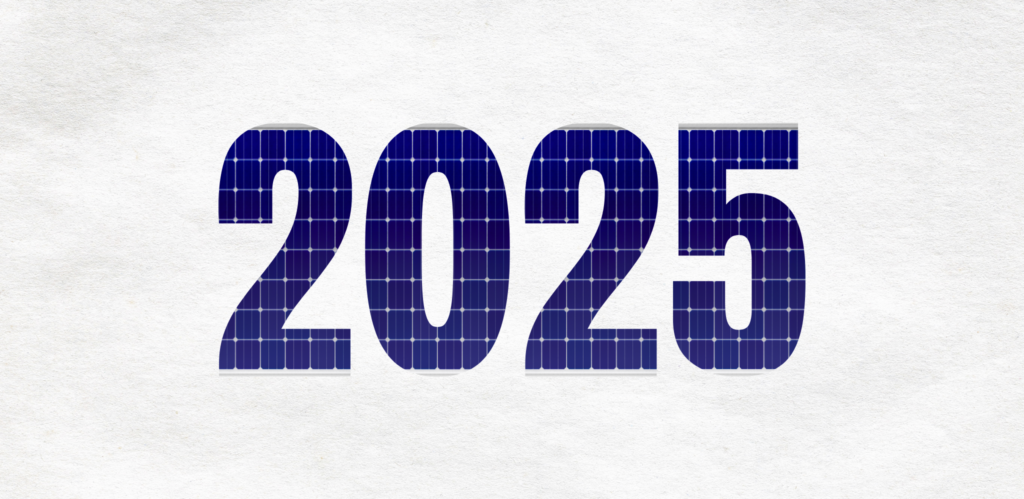
2024 was a mixed bag for the solar industry. Commercial and utility-scale development saw large gains and continued growth, while residential solar saw declines in install volumes, mainly due to increased interest rates. Even with some hiccups though, industry leaders see a bounce back in 2025 for residential and an even greater explosion in the energy storage market.
With 2024 now in the rearview mirror, we have the benefit of hindsight to analyze the solar industry and anticipate what lies ahead in 2025. I had the opportunity to sit down with a few of our leaders at Solar Insure—Ara Agopian, our CEO; Dean Chiaravallotti, our CRO; and Marie Burgquist, our Director of Marketing.
Together, they reflected on the past year and shared their insights into the trends they believe will shape the solar landscape in the year ahead. Their perspectives provide valuable guidance as we plan for another year of innovation and growth.
Table of Contents
What Trends Did You See in 2024?
“The residential battery storage market showed growth opportunities as grid resilience became a priority for homeowners, supported by state and federal incentives making storage more accessible. While still a significant portion of the market, loan financing struggled in the high interest rate environment. With the Federal Reserve expected to continue cutting rates, the loan market will recover in 2025.
We also saw a trend of solar installer bankruptcies, although we anticipate the failure rate for solar installers to decrease in 2025.” – Ara
“AI has evolved from a niche technology to an essential tool across every department. From the support it gives on basic email rephrasing and meeting summarization to complex predictive data analysis, companies are leveraging AI to streamline operations, enhance efficiency, and enable data-driven decision-making.” – Marie
“Battery storage adoption surged in 2024, driven by supportive policies, financial incentives, and programs like Virtual Power Plants (VPP). Homeowners increasingly prioritized resilience, and contractors who leaned into battery upgrades saw measurable success.”
“String inverters began taking off in a big way. With the introduction of UL3740 standards, contractors started moving toward string inverter systems to cut component costs, reduce failure points, and improve long-term reliability. This shift simplifies installations and enhances overall system efficiency—benefiting both contractors and homeowners.”
“In the residential space, contractors doubled down on expanding their services. Diagnostics, re-roofing, and battery retrofits became standard offerings for many businesses, positioning them not just as solar installers but as energy consultants.”
“Financing also saw important shifts. Innovations like zero-dealer fee loans gained traction, offering contractors better tools to close deals profitably while keeping financing accessible for homeowners. Overall, the theme of 2024 was clear: Adapt, specialize, and focus on long-term value.” –Dean
Batteries seem to be a big linchpin for solar in 2024 and will likely continue to be in 2025. With more and more states changing metering policies solar + storage will continue to be the norm. SEIA notes in their 2024 Q3 report that they expect 28% of all new distributed solar capacity will be paired with storage. AI integration is also an interesting note – many people use AI in their daily work lives but we’re curious to see how it will be implemented on a greater scale. One immediate use could be AI in monitoring systems to automatically monitor fleets and even auto-file RMAs. The possibilities are endless.
What were the non-mainstream obstacles solar businesses faced?
“One that comes to mind is the ripple effect caused by bad actors in the solar installation industry and the lasting impact they’ve had on prospective solar homeowners. These bad actors, often characterized by misleading sales tactics, subpar installations, or failure to honor warranties, have contributed to a significant loss of consumer trust in solar energy solutions. Homeowners who have experienced poor installations or unreliable service are more likely to share their negative experiences, creating a ripple effect that discourages others from considering solar energy.” – Marie
“Consistent attacks by utilities nationwide have been a major challenge, starting with California and the passage of NEM 3 laws. This has invigorated utilities with an anti-solar policy that has impacted the solar industry. Regulatory capture and increased lobbying pose a risk to solar energy and the shift to energy independence as utilities fight to maintain their monopoly against solar and distributed energy.” – Ara
“Beyond financing and supply chain issues, three significant obstacles stood out. Service backlogs created operational headaches, often underestimated in cost and complexity. The labor shortage added more pressure, making it challenging to maintain consistent quality and scale.”
“But perhaps the most overlooked challenge was the imbalance of power between sales-driven decisions and contractor accountability. Regulation is likely to step in and shift that power back to contractors, ultimately benefiting both customers and the long-term stability of the industry.” – Dean
Outside factors will always impact the solar industry whether we like them or not. With supply chain constraints, regulations, and some negative sentiment from homeowners squeezing the industry, it’s up to those of us in it every day to change the narrative
What did you see successful businesses do to overcome these obstacles?
“The most successful businesses focused on their strengths. They leaned into their core competencies, whether that was residential installs, battery integration, or diagnostics. At the same time, they found ways to diversify their revenue streams, tapping into opportunities like re-roofing, battery upgrades, and retrofits.”
“But the biggest differentiator was trust—not just through warranties, but by creating real transparency and focusing on long-term relationships over short-term gains. These businesses didn’t just react to challenges—they anticipated them and built resilience into their operations.” – Dean
“Successful businesses focused on improving operational efficiency and concentrating on regional markets. They also emphasized vertical integration and supplemented new sales with service and commercial work to diversify their revenue streams.
From an industry perspective, streamlining permitting is imperative. Countering the utility offensive and reducing solar installation costs will require working with industry organizations like the Solar Rights Alliance and Solar App+”.https://solarrights.org/streamlinedpermitting/ – Ara
“Successful businesses overcame obstacles by focusing on consumer protection and education. They prioritized building trust and transparency with homeowners, especially in an industry impacted by bad actors. By offering clear warranty terms, detailed information on the installation process, and ongoing maintenance support, they ensured customers fully understood their solar investment. These businesses also emphasized education, providing accessible resources on solar’s benefits, financing options, and environmental impact through FAQs, webinars, and dedicated customer support. By combining strong warranties like those from Solar Insure with clear educational outreach, they are focused on establishing credibility, setting themselves apart from the other organizations unwilling to take this extra step.” – Marie
The core message here is simple, successful solar providers overcome obstacles by putting their customers first and focusing energy on building trust and honesty. Sitting on the same side of the table as their customers and pitching solutions, rather than products, elevates the industry and helps them build the identity they need to thrive.
What do you think will happen with the industry in 2025?
“In 2025, I expect to see more consolidation, both on the contractor and manufacturer sides, with M&A activity increasing and private equity firms taking a larger role. Established players from HVAC and roofing are entering the solar market with efficiency and customer-first models that are hard to ignore.”
“My advice for contractors going into 2025: Thrive in 2025. The market’s changing fast, and standing still isn’t an option. Contractors who focus on mastering their core strengths, diversifying revenue streams, and building trust with customers will lead the way.”
“The businesses that thrive in 2025 won’t be the ones chasing volume—they’ll be the ones delivering consistent, measurable value.” – Dean
“In my opinion, the residential solar industry will rebound in 2025. As demand for renewable energy and consumer protection increases, homeowners will increasingly turn to solar solutions, with regional EPCs gaining more market share over national companies. Additionally, I expect (maybe more of a hope) a potential lowering of interest rates, which will make financing more accessible and affordable, further boosting solar adoption. Overall, 2025 could be a pivotal year for the residential solar market, driven by local providers and improved financing options.” – Marie
“I am positive and have conviction the industry will improve by 10-15%, though with a few additional road bumps ahead. Battery storage systems are increasingly seen as an essential complement to solar installations, and with prices continuing to fall and incentives rising, the market is poised for continued growth through 2025 and beyond.
A concerning trend that may emerge in 2025 is the potential failure of some solar manufacturers. It’s possible that we could see a few failures across panel, inverter, and battery manufacturers. Additionally, there is a strong possibility of another large national TPO failing in 2025, similar to the SunPower collapse in 2024.” – Ara
Overall, 2025 is a year that brings a lot of hope for the solar industry even in the face of some outside dangers. Solar solutions make sense for homeowners and with a focus on making their best better and putting customers first, residential solar providers can flourish in 2025.


